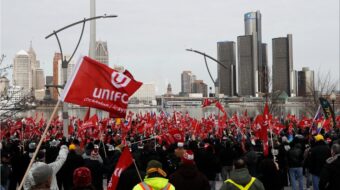
Two recent government reports cut through all the rhetoric and posturing, expose the heart of the ongoing economic crisis and what must be addressed if there is to be a real recovery. The first, released this week by the Labor Department, shows, despite some abatement in the recession, that workers’ share of national income has plummeted to an all-time low.
The second, which emphasizes the same point, consists in startling data released by the U.S. Commerce Department that wages grew more slowly in the last decade than at any time since 1939. Between 1929 and 1939, the period including the Great Depression, real wages grew only 5 percent, but every year since then wages grew by more, at least 16 percent over the previous 10 years. That is, until now, when wages have grown only 4 percent since 2001.
Since consumer demand accounts for 70 percent of the U.S. economy, both these reports reflect what is at the heart of the prolonged economic crisis and the reason for the extremely slow recovery.
Big business is basking in record profits and sitting on an estimated $2 trillion in liquid assets. The corporations have ample resources for hiring workers and expanding production. But why should they, if consumer demand is so low and stagnant? The great majority of Americans are struggling to survive. Any meager wage gains are consumed by rising costs of basic necessities – food, fuel, health care – and paying off mortgages and other debt. Consumers have few resources to increase purchases of homes, manufactured goods and expensive services.
And why should the corporations risk new domestic investments when it is so much more lucrative to play in the Wall Street casino and invest in emerging markets abroad? That is the real reason they keep pressing for more free money, tax breaks, subsidies and corporate welfare. Their lackeys in the GOP say the handouts will create jobs, but the only jobs will be for hedge fund operators and workers elsewhere, not in the U.S.
The depressed working class income is the result of the past 30 years of ferocious class warfare involving relentless attacks on unions, cuts in all social services, the shift in the tax burden to working people, outsourcing, speed-up and monopoly price gouging.
The hard fact is there is no solution to the crisis in the private sector. Only the government has the power to increase consumer demand, as it did during the Great Depression. That is at the heart of the AFL-CIO jobs program, which calls for rebuilding the decaying infrastructure, public investment in new green energy industries, aiding strapped schools and state and local governments to continue jobs and badly needed services, expanding unemployment benefits, health care and mortgage relief.
These and other measures to improve public buying power are the only way to give the private sector any incentive to hire workers and keep the ball rolling. If the Employee Free Choice Act is passed and unionization spreads, the process will accelerate even more and the possibility for widespread prosperity will occur.
But big business and its right-wing political allies will have none of this. They have dug in their heels and seek to escalate the attack on working people. The Republicans are pressing for more of the same policies that caused the crisis and believe that if it continues they will be able to blame President Obama and take power in 2012.
Ending the crisis requires a major shift in the political balance of forces. The battles being fought now against right-wing governments in states like Ohio and Wisconsin are dress rehearsals for the showdown next year, when it is essential to re-elect Obama with a strong Democratic majority in Congress. That, together with the growing upsurge by labor and its allies, can make achievement of the AFL-CIO jobs program a reality.










